May 24th, 2008
Earlier posts about the phenomena of Manhattanhenge: overview and map, and photos.
From the Hayden Planetarium’s “Star Struck” email announcement by astronomer Neal deGrasse Tyson:
It’s that time of year again….MANHATTANHENGE 2008
What will future civilizations think of Manhattan Island when they dig it up and find a carefully laid out network of streets and avenues? Surely the grid would be presumed to have astronomical significance, just as we have found for the pre-historic circle of large vertical rocks known as Stonehenge, in the Salisbury Plain of England. For Stonehenge, the special day is the summer solstice, when the Sun rose in perfect alignment with several of the stones, signaling the change of season.
For Manhattan, a place where evening matters more than morning, that special day comes on Thursday, May 29h this year, one of only two occasions when the Sun sets in exact alignment with the Manhattan grid, fully illuminating every single cross-street for the last fifteen minutes of daylight. The other day is Saturday, July 12th.
These two days give you a photogenic view with half the Sun above and half the Sun below the horizon — on the grid. The day after May 29th (Friday, May 30th), and the day before July 12 (Friday, July 11) will also give you Manhattanhenge moments, but instead you will see the entire ball of the Sun on the horizon — on the grid. My personal preference is the half-Sun.
As you may know, had Manhattan’s grid been perfectly aligned with the geographic north-south line, then the days of Manhattanhenge would be the spring and autumn equinoxes, the only two days on the calendar when the Sun rises due-east and sets due-west. But Manhattan’s street grid is rotated 30 degrees east from geographic north, shifting the days of alignment elsewhere into the calendar.
Note that any city crossed by a rectangular grid can identify days where the setting Sun aligns with their streets. But a closer look at such cities around the world shows them to be less than ideal for this purpose. Beyond the grid you need a clear view to the horizon, as we have over New Jersey. And tall buildings that line the streets create a kind of brick and steel channel to frame the setting Sun, creating a striking photographic opportunity.
True, some municipalities have streets named after the Sun, like Sunrise Highway on Long Island and the Sunset Strip in Los Angeles. But these roads are not perfectly straight. And the few times a year when the Sun aligns with one of their stretches of road, all you get is stalled traffic solar glare temporarily blinds drivers.
So Manhattanhenge may just be a unique urban phenomenon in the world, if not the universe.
Note that a couple of years ago, an article in the New York Times identified this annual event as the “Manhattan Solstice”. But of course, the word “solstice” translates from the Latin solstitium, meaning “stopped sun,” in reference to the winter and summer solstices where the Sun’s daily arc across the sky reaches its extreme southerly and northerly limits. Manhattanhenge comes about because the Sun’s arc has *not* yet reached these limits, and is on route to them, as we catch a brief glimpse of the setting Sun along the canyons of our narrow streets.
IMPORTANT: For best effect, position yourself as far east in Manhattan as possible. But ensure that when you look west across the avenues you can still see New Jersey. Clear cross streets include 14th, 23rd, 34th. 42nd, 57th, and several streets adjacent to them. The Empire State building and the Chrysler building render 34th street and 42nd streets especially striking vistas.
Arrive a half-hour earlier than the times given below.
MAY
Half Sun on grid: Thursday, May 29 — 8:17 p.m. EDT
Full Sun on grid: Friday, May 30 — 8:16 p.m. EDT
JULY
Half Sun on grid: Saturday, July 12 — 8:25 p.m. EDT
Full Sun on grid: Friday, July 11 — 8:24 p.m. EDT
Downloadable Image of the July 2001 “Manhattan Sunset” as it first appeared in 2002 among the photo-essays of “City of Stars,” Natural History magazine:
http://research.amnh.org/users/tyson/ManhattanSunset.php
December 14th, 2007
NYNYNY So nice we named it thrice
Opens today at Flux Factory [through January 2008]
Reception Friday December 14 , 7pm
From the press release:
“New York, New York, New York is an interactive, multimedia installation. It is a continuation of Flux Factory’s interest in urban landscapes and takes inspiration from the Panorama, Robert Moses’ scale model of New York City in the Queens Museum of Art. Members of the Flux Factory art collective will work in collaboration with over 100 artists from all five boroughs and around the world to re-imagine the public and private spaces of New York.
Each artist will contribute a building, a landmark, a street, an avenue, a block, a park, a neighborhood, an expressway, a bridge, an island, an airport—one or several elements of the urban environment. All of these individual works will be combined to produce a cohesive yet chaotic installation, a multimedia, scale-model of the city. Instead of being an exact replica to scale of the city of New York, this project offers a mental map, a replica of an imaginary New York. The goal of the show is to explore the architectural and conceptual elements of everyday space. It is an investigation into the collective unconscious of the cultural capital of the planet: The sum of all of New York’s potential exposed in a great experiment in psychogeography.”
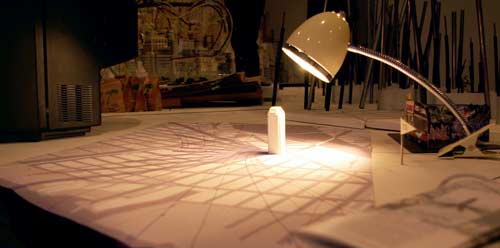
LIC Sundial model installed in Queens-panorama-area…and other installation views around NYNYNY:
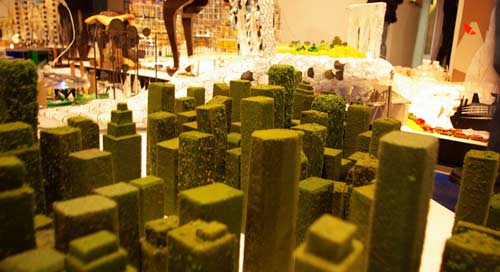
After Tomorrow – in the lower Manhattan financial district by Momoyo Torimitsu
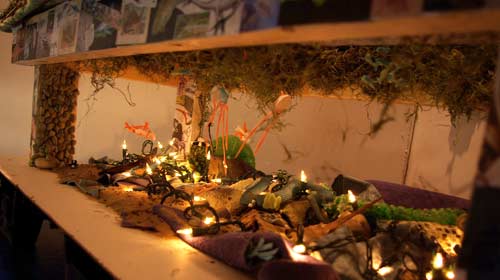
Cretaceous under Brooklyn (note to self to find artist name and piece title)
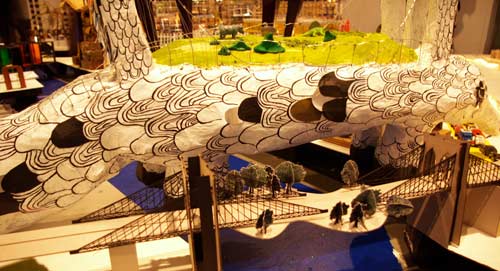
The Brooklyn Bridge with the Brooklyn Bridge
November 4th, 2007
The path of the New York City Marathon passes through the Long Island City Sundial at about miles 14 and 15, just before the Queensborough Bridge.

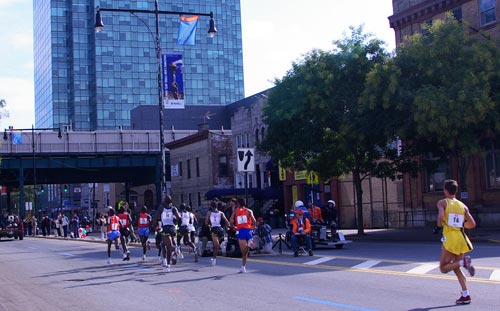
Leading men approach the LIC sundial gnomon.

Leading women, Paula Radcliffe and Gete Wami, emerge from the sundial shadow as the pass the gnomon.
July 29th, 2007

Rockefeller Center, opposite St. Patrick’s Cathedral on 5th Ave. in NYC.
Lee Lawrie and Rene Chambellan, installed in 1937.
From The Art of Rockefeller Center by Christine Roussel:
“Atlas had waged and lost a ten-year war against the gods of Mount Olympus. As punishment, the gods condemned Atlas to support the earth and the heavens on his back for eternity. He had grown weary of the task and was only too glad when Hercules offered to take over his burden. In turn, Hercules said he needed help to complete his eleventh labor, fetching the Golden Apples, which were closely guarded by nymphs called the Hesperides. Prometheus had told Hercules that Atlas could easily complete this labor as he was the nymphs’ father and knew their secrets. When Atlas returned with the apples, Hercules tricked him into resuming the burden of bearing the earth and the heavens on his back for eternity. This statue depicts that never-ending punishment.
The twenty-one-foot-diameter, openwork sphere bears the signs of the zodiac, and its axis points to the North Star. . . . The celestial sphere indicates the earth’s path around the sun, the change of the earth’s axis on its orbit, and the equinoxes.”
July 6th, 2007
Twice a year, in May and July, the sunset can be seen directly across Manhattan, down the middle of any crosstown street. This year the dates are May 30th and July 13–one week from today (although the general phenomena can be seen one or two days on either side).
The LIC Sundial’s gnomon is positioned directly across from 53rd street (as pictured here in June 25th post), which could set up some interesting eclipse-esque action next week. Here’s a diagram:

More on Manhattanhenge:
Hayden Planetarium’s description, post on BLDG/BLOG, flckr photos tagged ‘manhattanhenge.’
July 1st, 2007
Damian Ortega’s Obelisco Transportable

A 20-foot-tall, narrow, tapering object with a pyramidal top, Damián Ortega’s Obelisco Transportable stands on a grassy platform on wheels, as though it has been uprooted from a previous location and made portable. At Central Park’s 60th street x 5th avenue plaza until October 28, 2007. More info with the Public Art Fund
June 27th, 2007
A shadow-studies (among other things) non-profit, the Environmental Simulation Center is featured in the July 2 edition of The New Yorker–a great Talk of the Town article considering the effect of shadows from buildings in urban planning.
June 25th, 2007
Views of LIC Sundial gnomon from 53rd street at 5th Ave in Manhattan, looking East, and the Brooklyn Bridge, looking North.
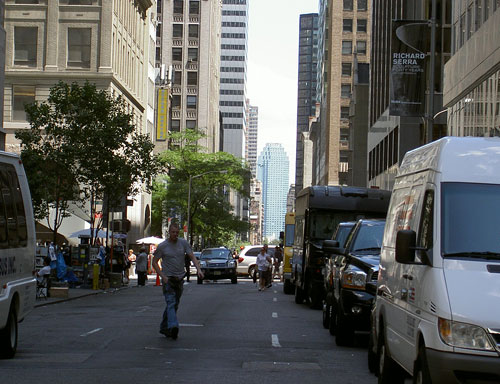

May 21st, 2007
Columbia University had a spherical sundial in the center of campus. It was removed in 1946 after some cracks made its structural integrity questionable. Thought to have been destroyed after removal, recently the sphere has inexplicably resurfaced in Michigan. Here are images of the this sundial as depicted in a vintage postcard, and the same spot today.
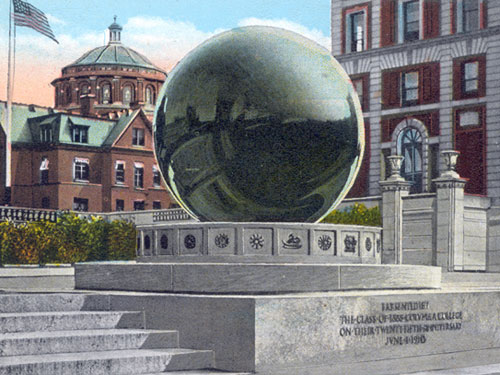
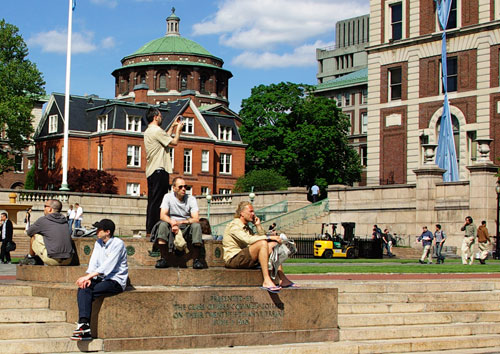
More info:
Columbia sundial history
116th was Gnomon’s Land













